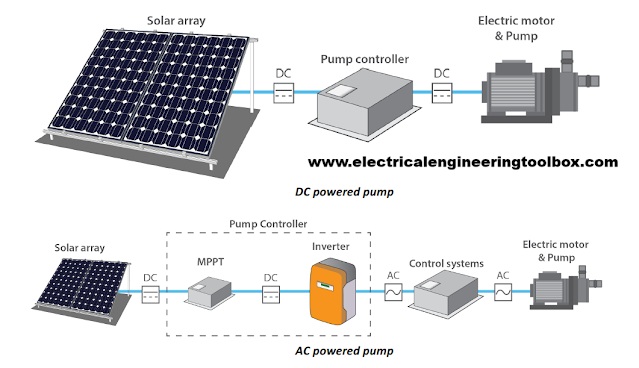
Solar water pumping systems have revolutionized access to clean and reliable water for various needs, including irrigation, livestock care, and household use. These systems utilize renewable solar energy to pump water, making them an efficient, eco-friendly, and cost-effective solution for regions with unreliable electricity or high energy costs. Here's a detailed guide on how these systems work, the types available, and the benefits they provide.
How Solar Water Pumping Systems WorkSolar water
pumping systems harness sunlight to operate water pumps. The key components of
these systems include:
1. Solar Panels
Photovoltaic
(PV) panels are the foundation of solar water pumping systems. These panels
capture sunlight and convert it into direct current (DC) electricity. The
energy generated depends on the size, efficiency, and sunlight availability in
the location.
2. Controller/Inverter
The
electricity generated by the solar panels flows through a controller or
inverter. This component regulates the power output, ensuring that the pump
operates efficiently. In setups using AC pumps, an inverter converts DC
electricity to alternating current (AC) for compatibility.
3. Water Pump
The water
pump, powered by the electricity from the solar panels, extracts water from a
borehole, reservoir, or other sources. Solar water pumps can be DC or AC
powered, depending on the system's configuration.
4. Water Storage System
To ensure a
consistent water supply during low sunlight periods or at night, many systems
include storage tanks. These tanks collect water during peak sunlight hours for
later use, making the system reliable in all weather conditions.
Types of Solar Water Pumping Systems
Solar water
pumping systems are designed to meet diverse requirements, and they come in
various configurations:
Standalone Systems
Standalone
systems rely exclusively on solar panels for power. They are ideal for areas
without grid electricity and where complete energy independence is desired.
Hybrid Systems
Hybrid
systems combine solar energy with other power sources, such as grid electricity
or diesel generators. This setup ensures that water demands are met even during
prolonged low sunlight periods.
Direct-Drive Systems
In
direct-drive systems, solar panels directly power the water pump, bypassing the
need for a battery. These systems are cost-effective and efficient for daytime
operation.
Battery-Integrated Systems
These
systems store excess solar energy in batteries, ensuring water availability
during nighttime or cloudy weather. They are suitable for areas with high water
demand at all times.
Types of Water Pumps Used in Solar Systems
Selecting
the right water pump is critical for the system's performance and efficiency.
The main types include:
- Submersible Pumps: Best for deep boreholes and wells, capable of pumping water from
significant depths.
- Surface Pumps: Ideal for shallow water sources such as ponds and reservoirs, and
are easy to install and maintain.
- Centrifugal Pumps: Commonly used for irrigation, they rely on centrifugal force to
move water and are suited for shallow sources.
- Positive Displacement Pumps: Deliver a fixed volume of water per cycle and are perfect for
high-pressure applications.
Benefits of Using Solar Water Pumping Systems
Solar water
pumping systems offer numerous advantages that make them a compelling choice
for water access:
1. Cost Savings
Once
installed, solar water pumps eliminate recurring energy costs for electricity
or fuel. Additionally, these systems have minimal maintenance requirements,
leading to long-term operational savings.
2. Environmental Sustainability
By relying on solar energy, these systems produce no greenhouse gas emissions, reducing the carbon footprint compared to traditional fuel-powered pumps.
3. Reliability
Solar water
pumps operate effectively in regions with unreliable grid electricity, ensuring
a consistent water supply. Their dependence on widely available sunlight makes
them ideal for remote and off-grid locations.
4. Flexibility
These
systems are adaptable and scalable, making them suitable for various
applications, from small-scale domestic use to large-scale agricultural
operations.
5. Improved Livelihoods
Solar water
pumps reduce the time and effort required for water collection, enabling
households to focus on other productive activities. For farmers, access to
reliable water supply increases agricultural productivity and income.
Solar water
pumping systems are an innovative and sustainable solution for water access
challenges. By leveraging abundant sunlight, they provide an environmentally
friendly, cost-effective, and reliable alternative to traditional water pumping
methods. Whether for rural areas, urban settings, or regions with energy-saving
goals, solar water pumping systems are paving the way for a more sustainable
future.

